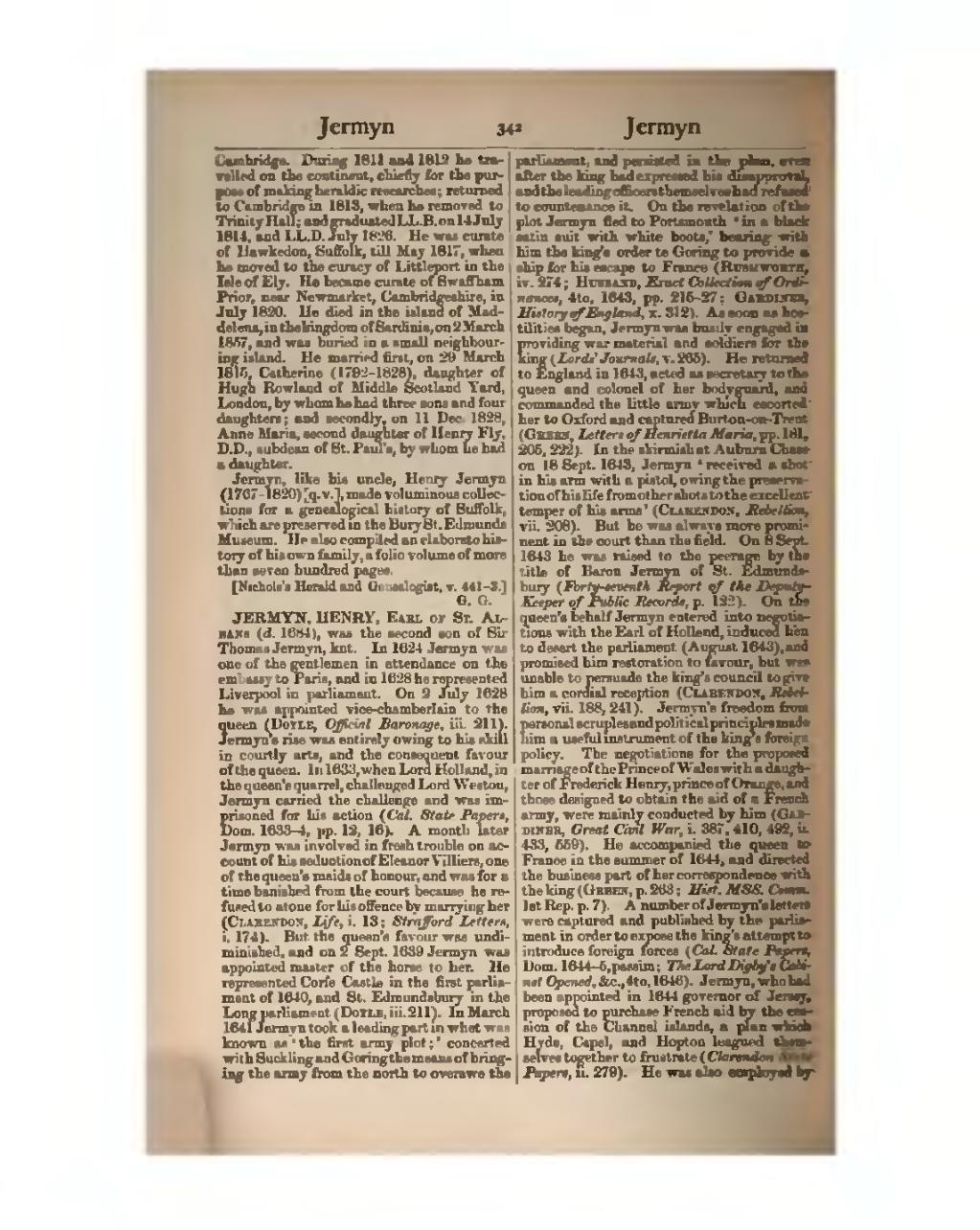Cambridge. During 1811 and 1812 he travelled on the continent, chiefly for the purpose of making heraldic researches; returned to Cambridge in 1813, when he removed to Trinity Hall; and graduated LL.B. on 14 July 1814, and LL.D. July 1826. He was curate of Hawkedon, Suffolk, till May 1817, when he moved to the curacy of Littleport in the Isle of Ely. He became curate of Swaffham Prior, near Newmarket, Cambridgeshire, in July 1820. He died in the island of Maddelena, in the kingdom of Sardinia, on 2 March 1857, and was buried in a small neighbouring island. He married first, on 29 March 1815, Catherine (1792–1828), daughter of Hugh Rowland of Middle Scotland Yard, London, by whom he had three sons and four daughters; and secondly, on 11 Dec. 1828, Anne Maria, second daughter of Henry Fly, D.D., subdean of St. Paul's, by whom he had a daughter.
Jermyn, like his uncle, Henry Jermyn (1767–1820) [q. v.], made voluminous collections for a genealogical history of Suffolk, which are preserved in the Bury St. Edmunds Museum. He also compiled an elaborate history of his own family, a folio volume of more than seven hundred pages.
[Nichols's Herald and Genealogist, v. 441–3.]
JERMYN, HENRY, Earl of St. Albans (d. 1684), was second son of Sir Thomas Jermyn, knt., by Mary Barber. In 1624 Jermyn was gentleman in attendance on the embassy to Paris, and in 1628 he represented Liverpool in parliament. On 2 July 1628 he was appointed vice-chamberlain to the queen (Doyle, Official Baronage, iii. 211). Jermyn's rise was entirely owing to his skill in courtly arts, and the consequent favour of the queen. In 1633, when Lord Holland, in the queen's quarrel, challenged Lord Weston, Jermyn carried the challenge and was imprisoned for his action (Cal. State Papers, Dom. 1633–4, pp. 12, 16). A month later Jermyn was involved in fresh trouble on account of his seduction of Eleanor Villiers, one of the queen's maids of honour, and was for a time banished from the court because he refused to atone for his offence by marrying her (Clarendon, Life, i. 13; Strafford Letters, i. 174). But the queen's favour was undiminished, and on 2 Sept. 1639 Jermyn was appointed master of the horse to her. He represented Corfe Castle in the first parliament of 1640, and St. Edmundsbury in the Long parliament (Doyle, iii. 211). In March 1641 Jermyn took a leading part in what was known as ‘the first army plot;’ concerted with Suckling and Goring the means of bringing the army from the north to overawe the parliament, and persisted in the plan, even after the king had expressed his disapproval, and the leading officers themselves had refused to countenance it. On the revelation of the plot Jermyn fled to Portsmouth ‘in a black satin suit with white boots,’ bearing with him the king's order to Goring to provide a ship for his escape to France (Rushworth, iv. 274; Husband, Exact Collection of Ordinances, 4to, 1643, pp. 215–27; Gardiner, History of England, x. 312). As soon as hostilities began, Jermyn was busily engaged in providing war material and soldiers for the king (Lords' Journals, v. 265). He returned to England in 1643, acted as secretary to the queen and colonel of her bodyguard, and commanded the little army which escorted her to Oxford and captured Burton-on-Trent (Green, Letters of Henrietta Maria, pp. 181, 205, 222). In the skirmish at Auburn Chase on 18 Sept. 1643, Jermyn ‘received a shot in his arm with a pistol, owing the preservation of his life from other shots to the excellent temper of his arms’ (Clarendon, Rebellion, vii. 208). But he was always more prominent in the court than the field. On 8 Sept. 1643 he was raised to the peerage by the title of Baron Jermyn of St. Edmundsbury (Forty-seventh Report of the Deputy-Keeper of Public Records, p. 122). On the queen's behalf Jermyn entered into negotiations with the Earl of Holland, induced him to desert the parliament (August 1643), and promised him restoration to favour, but was unable to persuade the king's council to give him a cordial reception (Clarendon, Rebellion, vii. 188, 241). Jermyn's freedom from personal scruples and political principles made him a useful instrument of the king's foreign policy. The negotiations for the proposed marriage of the Prince of Wales with a daughter of Frederick Henry, prince of Orange, and those designed to obtain the aid of a French army, were mainly conducted by him (Gardiner, Great Civil War, i. 387, 410, 492, ii. 433, 559). He accompanied the queen to France in the summer of 1644, and directed the business part of her correspondence with the king (Green, p. 263; Hist. MSS. Comm. 1st Rep. p. 7). A number of Jermyn's letters were captured and published by the parliament in order to expose the king's attempt to introduce foreign forces (Cal. State Papers, Dom. 1644–5, passim; The Lord Digby's Cabinet Opened, &c., 4to, 1646). Jermyn, who had been appointed in 1644 governor of Jersey, proposed to purchase French aid by the cession of the Channel islands, a plan which Hyde, Capel, and Hopton leagued themselves together to frustrate (Clarendon State Papers, ii. 279). He was also employed by
